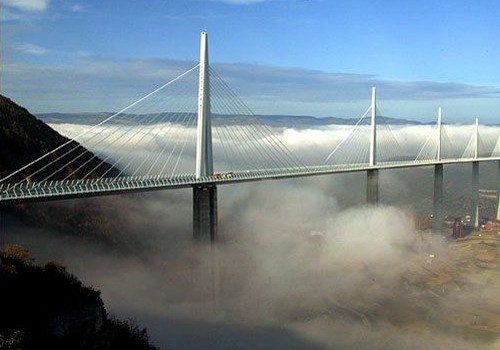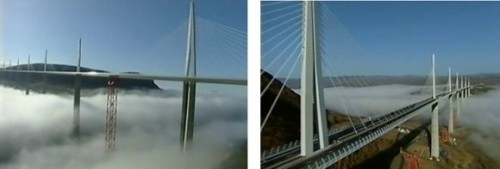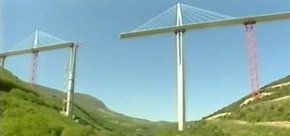 The Millau Bridge is in southern France and crosses the River Tarn in the Massif Central mountains. It was designed by the British architect Norman Foster and French structural engineer Michel Virlogeux. At 300m (984 feet), it is the highest road bridge in the world, weighing 36,000 tonnes. The central pillar is higher than the famous French icon, the Eiffel Tower. The Bridge opened in December 2004 and is possibly one of the most breath-taking bridges ever built.
The Millau Bridge is in southern France and crosses the River Tarn in the Massif Central mountains. It was designed by the British architect Norman Foster and French structural engineer Michel Virlogeux. At 300m (984 feet), it is the highest road bridge in the world, weighing 36,000 tonnes. The central pillar is higher than the famous French icon, the Eiffel Tower. The Bridge opened in December 2004 and is possibly one of the most breath-taking bridges ever built.
The bridge towers above the Tarn Valley and the aim of Lord Foster was to design a bridge with the ‘delicacy of a butterfly’. Lord Foster designed a bridge that enhances the natural beauty of the valley, with the environment dominating the scene rather than the bridge. The bridge appears to float on the clouds despite the fact that it has seven pillars and a roadway of 1½ miles in length. On first sight, the impression is of boats sailing on a sea of mist. The roadway threads through the seven pillars like thread through the eye of a needle..
 The bridge was opened by President Jacques Chirac in December 2004. In his speech he praised the design saying that it was a ‘monument to French engineering genius’ and ‘a miracle of equilibrium’.
The bridge was opened by President Jacques Chirac in December 2004. In his speech he praised the design saying that it was a ‘monument to French engineering genius’ and ‘a miracle of equilibrium’.
The company, Eiffage, had a deadline of three years to build the bridge. Construction began on 10 October 2001. The bridge was entirely privately financed and cost 394 million euros (272 million pounds, 524 million dollars). It has 75 years to recover its investment by collecting receipts from a bridge toll.
Weather conditions in this part of France can be pretty harsh and that put work on the bridge behind schedule. The heatwave over the summer meant some of the welding couldn’t be done, and over the previous winter it was so cold some work had to be halted.
Without the bridge, many motorists heading to the south of France go through the small town of Millau. The town has only has a few thousand residents but it could take four hours to get through in the height of summer. While motorists will be happy to avoid the town, small business owners in particular fear they could lose passing trade as cars bypass the town.
The aim is to cut the travelling time to southern France, removing the traffic bottle neck at Millau, through the completion of the A75 motorway between Paris and Montpellier, on the Mediterranean.
The bridge took only three years to complete with new engineering techniques being employed. The traditional method of building a cable stay bridge involves building sections of the deck (roadway) and using cranes to put them in position. Because of its height, 900 feet above the valley floor, a new technique had to be developed.
First, the towers were built in the usual way, with steel reinforced concrete. The road way was built on either side of the valley and rolled into position, until it met with precision in the centre. This technique had never been tried before and it carried engineering risks. However, it proved to be an efficient method of deploying the roadway.
Germany’s Die Welt newspaper is impressed by the French approach to great technical projects. It says France had the “strength and the greatness” to ask British architect Norman Foster to design “a motorway bridge”, which, as the paper puts it, “now floats 245 metres above the river Tarn as if seven magic sails were carrying it through the clouds”. “The world’s tallest bridge has the silhouette of a cathedral of technology,” it enthuses.
Thanks to:
http://www.technologystudent.com/
http://www.youtube.com/national geographic/millau bridge
http://www.leviaducdemillau.com/ (Official website)


